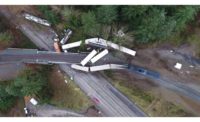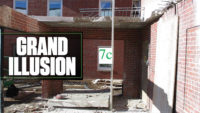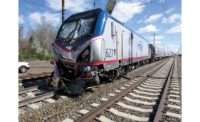Transportation
NTSB: Engineer's Distraction Is Probable Cause of 2015 Amtrak Crash
Safety Board also points to lack of positive train control system as contributing factor.

After yearlong investigation, NTSB also issued safety recommendations to Amtrak, FRA, transit and railroad organizations.
Photo Courtesy NTSB
The National Transportation Safety Board has determined that last May's Amtrak crash in Philadelphia probably stemmed from the engineer's being distracted, leading him to lose track of where he was and speed up into a curve at more than double the 50 mile per hour limit, causing a derailment that killed eight passengers and sent more than 180 others to area hospitals.
After a yearlong investigation, the board on May 19 cited engineer Brandon Bostian’s “loss of situational awareness” and resulting excessive speed, as the probable cause of the May 12, 2015, nighttime derailment.
The NTSB investigation showed that Bostian had been distracted by radio broadcasts in the minutes before the derailment from a Southeastern Pennsylvania Transportation Authority commuter rain heading south on the same rail corridor. The SEPTA train had made an emergency stop nearby after being hit by rocks, sending pieces of glass into its operator’s face.
But the NTSB also said that the absence of operating positive train control technology (PTC) was a contributing factor in the crash of Amtrak train 188, saying that the system could have prevented the train’s acceleration and derailment.
NTSB Chairman Christopher Hart called the accident “wholly preventable,” and noted that the board has called many times for U.S. railroads to install the PTC technology, beginning in 1970.
Amtrak had installed PTC on part of its Northeast Corridor by the time of the May crash, but it hadn’t been activated on the segment where the accident occurred, northeast of downtown Philadelphia.
Sarah Feinberg, head of the Federal Railroad Administration, told reporters, “There’s probably no better example of why we need PTC implemented as soon as possible as this accident.”
Congress in 2008 mandated that railroads install PTC by Dec. 31, 2015, but with most railroads expecting to miss the deadline, Congress last year extended that deadline to the end of 2018 and also permitted railroads to seek a further waiver, to 2020.
Speaking to reporters after the NTSB meeting, Amtrak President Joseph Boardman said that Amtrak now has PTC completely installed on the mainline of the Northeast Corridor and met the yearend 2015 deadline for installation. Most other railroads are far behind Amtrak’s implementation.
Hart said Amtrak had implemented PTC on all of the Northeast Corridor sections that it owns. A stretch of 56 miles that New York and Connecticut own is to get PTC by the end of 2018.
Asked what other administrative actions FRA can take to speed up PTC installation, Feinberg said the agency is collecting data from railroads and “posting it on line so that the public can view it and join with us in holding railroads’ feet to the fire.”
But with the PTC extension measure so recently enacted, Congress appears to have little interest in taking further action on the issue any time soon.
The board ruled out as possible factors such things as the train’s mechanical systems and track conditions. It also found that Bostian had passed alcohol and drug tests, wasn’t using his cell phone at the time of the accident and had a good record as an engineer.
Hart said that after examining those factors, the “best conclusion” NTSB was able to reach was that after being distracted, Bostian mistakenly thought he was a little farther along on the route than he actually was, possibly thinking he was on a section with a 110 mph speed limit.
Along with its findings, the NTSB issued 11 new safety recommendations, including one for Amtrak, calling for the railroad to add to its crewmembers’ training strategies to handle multiple tasks in “prolonged, atypical situations” and maintain focus on train operations.
It made a similar training recommendation to the American Public Transportation Association and the Association of American Railroads.
Most of the new NTSB recommendations were directed to the Federal Railroad Administration. They include requiring railroads to install equipment to help crews identify their location and display their route in areas where PTC won’t be installed.
Last July, less than two months after the crash, NTSB issued a recommendation to Amtrak, and reiterated an earlier recommendation to FRA, to install inward- and outward-facing video and audio recorders in locomotive cabs. The new report repeats both of those items.
The NTSB has no regulatory authority.
Boardman said, “We’re going to take what the NTSB has told us today and look for improvements at Amtrak.”
He added that Amtrak officials believe they know what improvements need to be made in its employee training. “We have an excellent training program for engineers,” Boardman said. “We’ll now adjust that based on what the NTSB is talking about.
“This derailment is just such a textbook case of an engineer who has an unblemished record. He has no problems in his background. He has good training," said Hart. "But this shows that any human, on even their best day, can make a mistake. And that’s the reason that PTC is so important."
Hart said it’s “very disappointing” that most railroads didn’t meet the 2015 deadline for installing the technology, adding, “as far as we’re concerned, the [new] deadline is not 2018. The deadline is the next PTC-preventable crash.”






